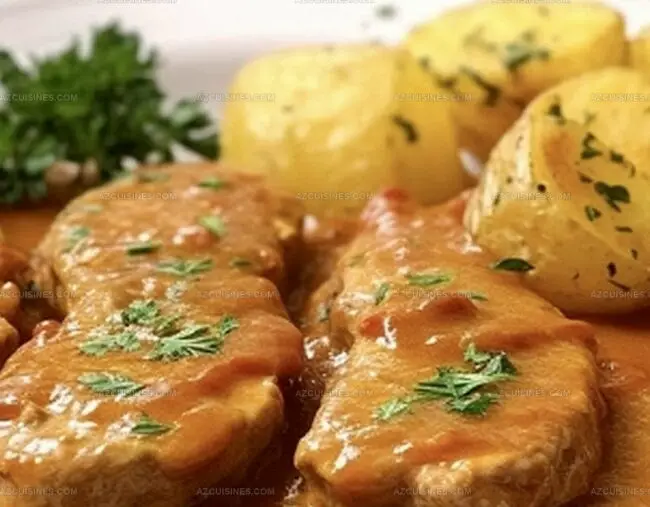The Juiciest Classic Oven-Roasted Pork Tenderloin Recipe
Succulent and tender pork tenderloin emerges as a culinary champion in this classic oven-roasted masterpiece.
Marinades infuse incredible depth into every delectable bite.
Juicy meat promises a mouthwatering experience that will delight your palate.
Simple ingredients combine to create something truly spectacular.
Minimal preparation meets maximum flavor in this straightforward recipe.
Crispy exterior and perfectly cooked interior guarantee a memorable meal.
Savor each slice knowing you’re about to enjoy an exceptional dinner that impresses without complexity.
What’s to Love About Classic Oven-Roasted Pork Tenderloin
Ingredients You’ll Need for Classic Oven-Roasted Pork Tenderloin
Meat:Aromatics and Vegetables:Liquids and Seasonings:Cooking Guide for Classic Oven-Roasted Pork Tenderloin
Step 1: Prepare the Oven
Crank up your oven to a toasty 350°F. Grab a large cast-iron skillet or roasting pan ready for action.
Step 2: Season the Meat
Lovingly massage the pork tenderloin with:Ensure every inch gets coated with the herbal goodness.
Step 3: Create a Flavorful Sear
Heat olive oil in the skillet over medium-high heat.
Gently place the tenderloin and sizzle until each side develops a gorgeous golden-brown crust, about 2-3 minutes per side.
Step 4: Build a Vegetable Foundation
Toss into the same skillet:Sauté until vegetables become tender and slightly caramelized, releasing their sweet aromatics.
Step 5: Deglaze with Liquid Magic
Pour in a splash of dry white wine or chicken broth. Scrape up those delicious browned bits stuck to the pan’s bottom, creating an instant flavor boost.
Step 6: Slow Roast to Perfection
Transfer the skillet directly into the preheated oven. Roast the tenderloin for 25-30 minutes until the internal temperature reaches 145°F.
Step 7: Rest and Slice
Remove from oven and let the meat rest for 5-7 minutes. This allows juices to redistribute, ensuring maximum tenderness.
Slice against the grain for the most succulent bites.
Step 8: Plate and Garnish
Arrange sliced tenderloin on a warm platter.
Spoon the caramelized vegetables and pan juices over the top. Sprinkle with fresh chopped parsley for a burst of color and freshness.
Useful Tips for Juicy Pork Tenderloin Every Time
Twist Ideas for Classic Oven-Roasted Pork Tenderloin
Great Sides for Classic Oven-Roasted Pork Tenderloin
How to Store Classic Oven-Roasted Pork Tenderloin Properly
FAQ Guide for Classic Oven-Roasted Pork Tenderloin
Use a meat thermometer to check the internal temperature. It should reach 145°F (63°C) for safe and juicy meat. When you remove the pork from the oven, let it rest for a few minutes to allow the juices to redistribute.
Chicken breasts or beef tenderloin can work as alternatives. However, cooking times and temperatures might vary slightly, so always use a meat thermometer to ensure proper doneness.
Searing creates a delicious golden-brown crust that locks in flavor and helps seal the meat’s moisture. It also develops rich caramelized notes that enhance the overall taste of the dish.
Print
Classic Oven-Roasted Pork Tenderloin Recipe
- Total Time: 45 minutes
- Yield: 4 1x
Description
Succulent classic oven-roasted pork tenderloin marries robust herbs with tender meat, creating a mouthwatering centerpiece for family dinners. Guests will savor each perfectly seasoned slice, experiencing a culinary journey of rich flavors and comforting home-style cooking.
Ingredients
Meat:
- 1 pork tenderloin (700 g / 24.7 oz)
Vegetables:
- 3 onions, sliced
- 1 carrot, sliced
- 3 garlic cloves, minced
Liquids and Seasonings:
- 2 tablespoons extra virgin olive oil
- 100 milliliters white wine or broth
- 250 milliliters broth
- 1 bay leaf
- Salt
- Pepper
Instructions
- Preheat the oven to 175°C (350°F), preparing a robust cooking environment for the pork tenderloin.
- Generously season the entire surface of the pork with salt and pepper, ensuring comprehensive flavor coverage.
- Heat extra virgin olive oil in a large oven-safe skillet over medium-high heat until shimmering and hot.
- Carefully place the tenderloin in the skillet, searing each side for 2-3 minutes to develop a rich, golden-brown exterior that locks in moisture.
- Transfer the seared pork to a temporary plate, maintaining its heat and juiciness.
- In the same skillet, introduce sliced onions, garlic, and carrots, sautéing until they soften and caramelize slightly, approximately 5-7 minutes.
- Deglaze the pan with white wine or broth, using a wooden spoon to scrape up the flavorful browned bits from the skillet’s bottom.
- Allow the liquid to reduce by half, then add remaining broth and bay leaf, creating a fragrant cooking liquid.
- Gently return the pork to the skillet, nestling it among the vegetables and sauce.
- Transfer the skillet to the preheated oven, roasting for 25-30 minutes until the internal temperature reaches 145°F (63°C).
- Remove from the oven and let the tenderloin rest for 3-5 minutes to redistribute its juices.
- Slice the pork and plate with the sautéed vegetables, drizzling the pan sauce over the top for maximum flavor.
Notes
- Avoid overcooking the pork tenderloin to maintain its juicy, tender texture by using a meat thermometer to check the internal temperature precisely.
- Create a flavor-packed marinade with herbs like rosemary or thyme before searing to enhance the meat’s natural taste and add depth to the dish.
- Substitute white wine with chicken broth or apple cider for a non-alcoholic version that still provides rich, complex flavor to the sauce and vegetables.
- Customize the dish for low-carb diets by replacing carrots with low-carb vegetables like zucchini or bell peppers, keeping the meal nutritious and diet-friendly.
- Prep Time: 10 minutes
- Cook Time: 35 minutes
- Category: Dinner, Lunch
- Method: Roasting
- Cuisine: American
Nutrition
- Serving Size: 4
- Calories: 210
- Sugar: 2 g
- Sodium: 480 mg
- Fat: 10 g
- Saturated Fat: 1.5 g
- Unsaturated Fat: 8 g
- Trans Fat: 0 g
- Carbohydrates: 6 g
- Fiber: 1 g
- Protein: 28 g
- Cholesterol: 75 mg




Truc Tran (Kris)
Senior Food Editor
Expertise
Home Cooking, Meal Planning, Recipe Development, Baking and Pastry, Food Editor, Cooking-video Maker, Vietnamese Food Evaluation Expert
Education
Truc Tran (Kris), an experienced food writer and editor, is great at exploring and describing global cuisines, from simple street food to fancy dining. In her writing, she skillfully mixes different flavors, cooking methods, and culinary traditions, showing the unique character of various cultures through their food and drinks. On azcuisines.com, Kris highlights her knowledge, especially in Asian cuisine and worldwide traditional dishes.